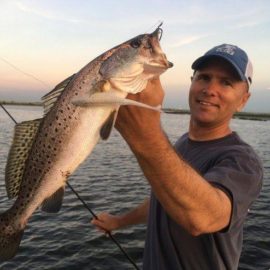
If you over fish and the catch goes down don’t be surprised if the catch limits are lowered.
State fisheries regulators are proposing substantially lower catch limits for the popular but likely overfished speckled trout. Louisiana Department of Wildlife and Fisheries biologists are recommending that the daily catch limit of speckled trout, also known as spotted seatrout, should be reduced from 25 to 15 fish per angler. The proposal would also change the minimum trout size limit from one foot in length to 13.5 inches. The change is aimed at protecting more small, spawning-age female trout. The Wildlife and Fisheries Commission on Thursday approved a “notice of intent” that clears the way for a period for public comment and an eventual resolution on the matter. If enacted as proposed, the rules would likely go into effect sometime next year.
nola.com
This is the first change in 30 years and it is a welcome one to the anglers.
The state’s speckled trout catch and size limits haven’t undergone a substantial update since the late 1980s. The state has considered similar rule changes in recent years. The most recent proposal began taking shape last spring. Many anglers and fishing guides support the changes, calling them an overdue response to an all-too-obvious drop in the trout populations. “This resource is no longer a bottomless barrel,” said Eric Newman, a Venice charter boat captain. “Leaving more fish in the water is never a bad thing.” In the early 1990s, anglers were catching an average of about six fish per trip. Now they’re catching half as many. The share of spawning-age female trout in the state’s annual recreational catch has dropped from about 20% to 7% over the past 20 years in many parts of the coast, indicating the species is having trouble maintaining its population.
Of course there were those who disagreed.
Several anglers who spoke at the commission’s meeting Thursday disagreed with the proposed size limit, saying it will lead to an increase in throwbacks. Many hooked fish are injured or in shock when released, increasing their likelihood of dying or being eaten by predators. Catching fewer fish won’t be enough to revive the stock, said Wildlife and Fisheries Commission Chair William “Joe” McPherson. He noted that a range of environmental stressors are harming several fish species, including redfish and other popular catches. Likely the biggest problem, he and other anglers said, is habitat loss. “The loss of marsh habitat is there, and we see that,” McPherson said.
Noting the loss of land is a correct call.
Coastal erosion and rising seas have robbed Louisiana of land equivalent to the size of Delaware over the past century. Louisiana could lose two more Delawares in the next half-century if no action is taken to stop it, according to the state’s coastal scientists. The main causes of land loss – climate change, Mississippi River levees, subsidence, erosion from oil and gas canals – are too big for a state wildlife agency to tackle alone. But limiting the recreational catch of an imperiled species is one step it can take, McPherson added. He stressed that the proposed rule changes are “not set in stone” and may change as the commission gathers more input from the public. “This is a work in progress,” he said. “I think everybody can agree we all want this state to remain the sportsman’s paradise. Sometimes we forget how good we’ve had it for so long.”
Sadly the good old days meant over fishing.

